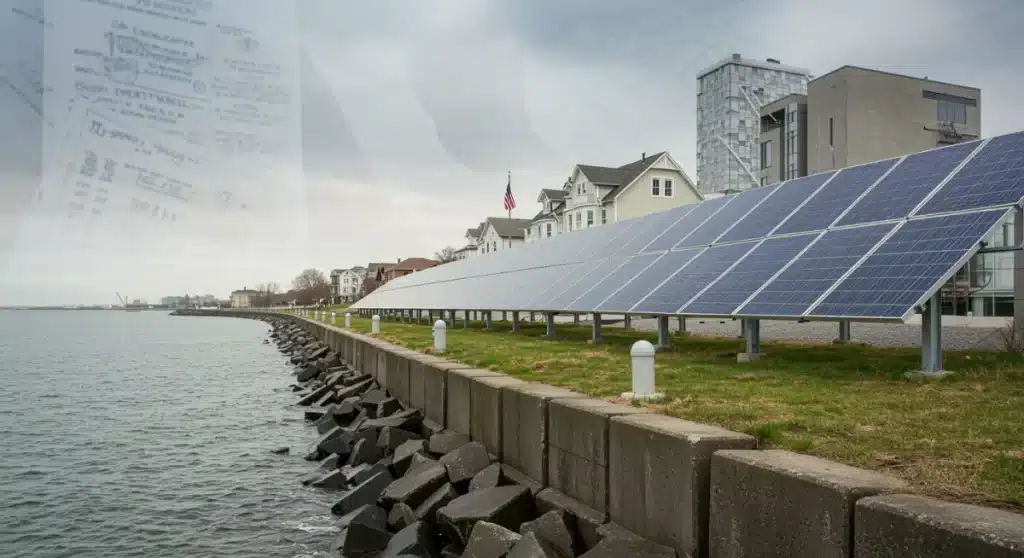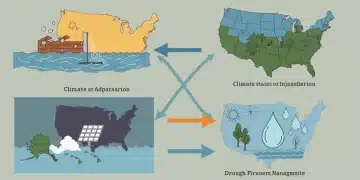Federal Funding for Climate Resilience: $10 Billion 2025 Opportunities

Over $10 billion in federal funding is slated for climate resilience initiatives in 2025, offering critical resources for communities to adapt to environmental changes. This influx aims to bolster infrastructure and mitigate risks.
As the impacts of climate change intensify across the nation, the urgency for robust adaptation and mitigation strategies grows. In a significant development, the federal government is poised to release over $10 billion in 2025 federal funding for climate resilience, marking a pivotal moment for communities seeking to fortify against environmental threats. This substantial investment underscores a renewed commitment to safeguarding infrastructure, ecosystems, and human lives from the escalating challenges posed by a changing climate.
Unpacking the $10 Billion Climate Resilience Allocation for 2025
The upcoming allocation of over $10 billion in federal funding for climate resilience in 2025 represents a critical injection of resources into a field demanding urgent action. This substantial sum is designated to support a wide array of projects, from coastal protection and flood mitigation to wildfire prevention and sustainable infrastructure development. The overarching goal is to enhance the nation’s capacity to withstand and recover from climate-related disasters, moving beyond reactive responses to proactive preparation.
Recent legislative actions and executive orders have laid the groundwork for this significant financial commitment. The administration has emphasized that these funds are not merely for rebuilding after disasters but are primarily aimed at pre-disaster mitigation and long-term resilience planning. This strategic shift reflects a growing understanding that investing in resilience today can prevent far greater economic and social costs tomorrow.
Key Funding Streams and Agencies
Several federal agencies are central to the distribution of these funds, each focusing on specific aspects of climate resilience. Understanding these pathways is crucial for potential applicants.
- FEMA (Federal Emergency Management Agency): Continues to be a major player through programs like the Building Resilient Infrastructure and Communities (BRIC) program, which prioritizes pre-disaster mitigation projects.
- NOAA (National Oceanic and Atmospheric Administration): Supports coastal resilience, habitat restoration, and weather forecasting improvements vital for climate adaptation.
- EPA (Environmental Protection Agency): Funds initiatives related to water infrastructure, green infrastructure, and community-based resilience planning.
- HUD (Department of Housing and Urban Development): Offers grants for community development and disaster recovery, often with a focus on resilience.
Recent Federal Policy Shifts Driving Resilience Investment
The push for increased federal climate resilience funding is not arbitrary; it stems from a series of evolving policy shifts and legislative mandates. Over the past year, there has been a notable acceleration in governmental efforts to integrate climate considerations into national policy, reflecting both scientific consensus and the tangible impacts of extreme weather events. These policy changes are designed to streamline funding access, encourage innovative solutions, and ensure equitable distribution of resources across vulnerable communities.
One significant development is the emphasis on nature-based solutions. Federal agencies are increasingly prioritizing projects that utilize natural systems—such as wetlands, forests, and dunes—to mitigate climate risks, recognizing their cost-effectiveness and co-benefits for biodiversity and community well-being. This approach marks a departure from solely engineered solutions, promoting a more holistic view of resilience.
Legislative Milestones and Their Impact
Key legislation and recent executive actions have directly influenced the 2025 funding landscape. These policies provide the legal and financial frameworks for the allocation of billions of dollars.
- Infrastructure Investment and Jobs Act (IIJA): Continues to be a primary source for infrastructure-related resilience projects, with significant funding streams extending into 2025.
- Inflation Reduction Act (IRA): While focused on emissions reduction, it also contains provisions that indirectly support resilience through investments in clean energy infrastructure and environmental justice.
- Executive Orders: Recent executive orders have directed federal agencies to prioritize climate resilience in their planning and investments, ensuring a coordinated government-wide approach.
These policy shifts underscore a comprehensive strategy to embed resilience thinking into every layer of federal governance, moving beyond episodic disaster response to sustained, proactive engagement.
Financial Impact: Economic Benefits of Proactive Resilience
The financial impact of investing in climate resilience is increasingly clear, demonstrating that proactive measures offer significant economic benefits compared to the costs of inaction. Experts and government reports consistently show that every dollar invested in mitigation and adaptation can save multiple dollars in future disaster recovery and damages. This economic rationale is a core driver behind the substantial federal climate resilience funding allocated for 2025, shifting the narrative from cost to strategic investment.
Beyond direct savings from avoided damages, resilience investments also stimulate local economies by creating jobs in construction, engineering, environmental services, and related sectors. These projects often involve local labor and materials, fostering economic growth within the communities they serve. Furthermore, enhancing resilience can protect property values, ensure business continuity, and safeguard critical infrastructure, all of which contribute to long-term economic stability.
Quantifying the Returns on Investment
Studies by organizations like the National Institute of Building Sciences (NIBS) consistently highlight the impressive return on investment for resilience projects.
- Mitigation Saves: For every $1 invested in hazard mitigation, an average of $6 in future damages is avoided.
- Economic Growth: Resilience projects support local economies through job creation and increased demand for goods and services.
- Reduced Business Interruption: Businesses in resilient communities experience less downtime after extreme weather events, preserving revenue and employment.
- Protected Assets: Investments safeguard critical infrastructure, public services, and private property from climate impacts, maintaining their value and functionality.
This strong financial case is a key argument for policymakers advocating for continued and increased funding for climate adaptation measures, positioning these expenditures as essential fiscal responsibility rather than discretionary spending.
Key Opportunities for Communities and Organizations in 2025
With over $10 billion in federal funding for climate resilience on the horizon for 2025, a wealth of opportunities is emerging for states, local governments, tribes, non-profits, and even some private sector entities. Identifying and strategically pursuing these opportunities will be paramount for organizations looking to implement vital resilience projects. The upcoming funding cycles are expected to prioritize projects that demonstrate clear community need, innovative approaches, and a strong commitment to equity and environmental justice.
Prospective applicants should begin preparing now by assessing their vulnerabilities, developing robust project proposals, and forging partnerships. Federal agencies are often looking for projects that are scalable, replicable, and can serve as models for other communities. Early engagement with federal program officers and careful review of grant guidelines are critical steps in successfully navigating the application process.

Navigating the Grant Application Landscape
Securing federal funding requires a comprehensive understanding of application requirements and a strategic approach to proposal development.
- Needs Assessment: Clearly articulate the specific climate risks and vulnerabilities your community faces.
- Project Alignment: Ensure your proposed project directly aligns with the goals and priorities of the specific federal grant program.
- Partnerships: Collaborate with local organizations, academic institutions, and other governmental bodies to strengthen your proposal and demonstrate broad support.
- Data-Driven Proposals: Utilize scientific data and local knowledge to justify your project’s necessity and expected impact.
- Technical Expertise: Engage engineers, environmental scientists, and grant writers to develop a technically sound and compelling application.
These opportunities represent a chance for communities to transform their climate vulnerability into resilient strength, securing a safer and more sustainable future.
Challenges and Equity in Funding Distribution
While the prospect of over $10 billion in federal climate resilience funding for 2025 is encouraging, significant challenges persist, particularly concerning equitable distribution. Historically, smaller, under-resourced communities, often those most vulnerable to climate impacts, have struggled to access and manage complex federal grant processes. This disparity can exacerbate existing inequalities, leaving some populations further exposed to environmental hazards. Addressing these challenges is crucial to ensure that the funding achieves its intended purpose of broad-based resilience.
Federal agencies are increasingly aware of these equity concerns and are implementing measures to simplify application processes, provide technical assistance, and prioritize projects in disadvantaged communities. However, the onus also falls on states and larger regional entities to support their smaller counterparts in navigating the bureaucratic hurdles and developing competitive proposals. The goal is not just to distribute funds, but to ensure they reach those who need them most, promoting genuine resilience across all demographics.
Overcoming Barriers to Access
Several strategies are being deployed and advocated for to improve equitable access to resilience funding.
- Technical Assistance: Providing direct support to communities for grant writing, project design, and compliance.
- Simplified Applications: Streamlining application forms and requirements to reduce administrative burden.
- Capacity Building: Investing in local planning departments and community organizations to enhance their ability to manage complex projects.
- Set-Asides and Prioritization: Designating specific portions of funding or giving priority to projects in historically underserved areas.
- Inter-agency Coordination: Improving collaboration between federal agencies to offer holistic support and reduce fragmentation for applicants.
Ensuring that every community, regardless of size or resources, can benefit from these funds is paramount to building a truly resilient nation.
Future Outlook: Beyond 2025 and Long-Term Resilience Strategies
Looking beyond the immediate horizon of the $10 billion in federal funding for climate resilience in 2025, the long-term outlook for climate adaptation strategies suggests a sustained and evolving commitment. Experts anticipate that federal investment in resilience will not only continue but likely increase, driven by the accelerating pace of climate change and the growing economic imperative to protect national assets. This sustained focus will necessitate continuous innovation in resilience technologies, policy frameworks, and community engagement models.
Future resilience strategies are expected to emphasize integrated planning that considers interdependencies across sectors, from energy and water to transportation and public health. There will also be a greater focus on regional collaboration, recognizing that climate impacts often transcend jurisdictional boundaries and require coordinated responses. The role of data and technology, including advanced modeling and artificial intelligence, will become increasingly critical in informing decision-making and optimizing resource allocation for maximum impact.
Emerging Trends in Resilience Planning
Several key trends are expected to shape the future of climate resilience efforts.
- Nature-Based Solutions: Continued and expanded adoption of ecological approaches for climate adaptation.
- Climate-Smart Infrastructure: Development and deployment of infrastructure designed to be highly resistant to future climate impacts.
- Community-Led Resilience: Empowering local communities to lead their own resilience planning and implementation efforts.
- Risk Transfer Mechanisms: Exploration of innovative insurance and financial instruments to manage climate risks.
- Adaptive Governance: Developing flexible policy and regulatory frameworks that can adapt to changing climate conditions and scientific understanding.
The journey towards a climate-resilient future is ongoing, requiring persistent effort, strategic investment, and a willingness to adapt to new challenges and opportunities.
| Key Point | Brief Description |
|---|---|
| $10 Billion Allocation | Over $10 billion in federal funds earmarked for climate resilience projects in 2025. |
| Proactive Investment | Shift to pre-disaster mitigation and long-term resilience planning to save future costs. |
| Key Agencies | FEMA, NOAA, EPA, and HUD are primary distributors, each with specific resilience programs. |
| Equity Challenges | Ensuring equitable access for vulnerable, under-resourced communities remains a priority and challenge. |
Frequently Asked Questions About Federal Climate Resilience Funding
The main objective of the 2025 federal climate resilience funding is to enhance the nation’s capacity to withstand and recover from climate-related disasters. It focuses on proactive measures, such as pre-disaster mitigation and long-term resilience planning, rather than solely reactive responses, aiming to protect communities and infrastructure from escalating environmental threats.
Several key federal agencies are instrumental in distributing the 2025 climate resilience funds. These include the Federal Emergency Management Agency (FEMA), the National Oceanic and Atmospheric Administration (NOAA), the Environmental Protection Agency (EPA), and the Department of Housing and Urban Development (HUD), each managing programs tailored to specific resilience needs.
Communities should begin by conducting a needs assessment, aligning projects with federal grant program priorities, and forming partnerships. It’s crucial to develop data-driven proposals and engage technical experts for robust applications. Early engagement with federal program officers and thorough review of specific grant guidelines are also vital for success.
Investing in climate resilience offers significant economic benefits. For every dollar invested in mitigation, an average of $6 in future damages is avoided. These investments also stimulate local economies through job creation, reduce business interruption, and protect property values and critical infrastructure, contributing to long-term economic stability.
A major challenge is ensuring equitable access for smaller, under-resourced communities that often struggle with complex federal grant processes. Efforts are underway to address this through technical assistance, simplified applications, capacity building, and prioritizing projects in disadvantaged areas to prevent exacerbating existing inequalities.
What Happens Next
The unveiling of over $10 billion in federal climate resilience funding for 2025 sets a decisive course for national climate adaptation efforts. Moving forward, the focus will intensify on the effective and equitable deployment of these funds. Communities, particularly those most vulnerable, must proactively engage with federal agencies and prepare robust, data-driven proposals. Policymakers will likely continue to refine grant guidelines, emphasizing innovative, nature-based solutions and ensuring that technical assistance reaches all applicants. The coming months will be crucial for translating this significant financial commitment into tangible, on-the-ground resilience projects that protect lives, infrastructure, and economies from the escalating impacts of climate change.





